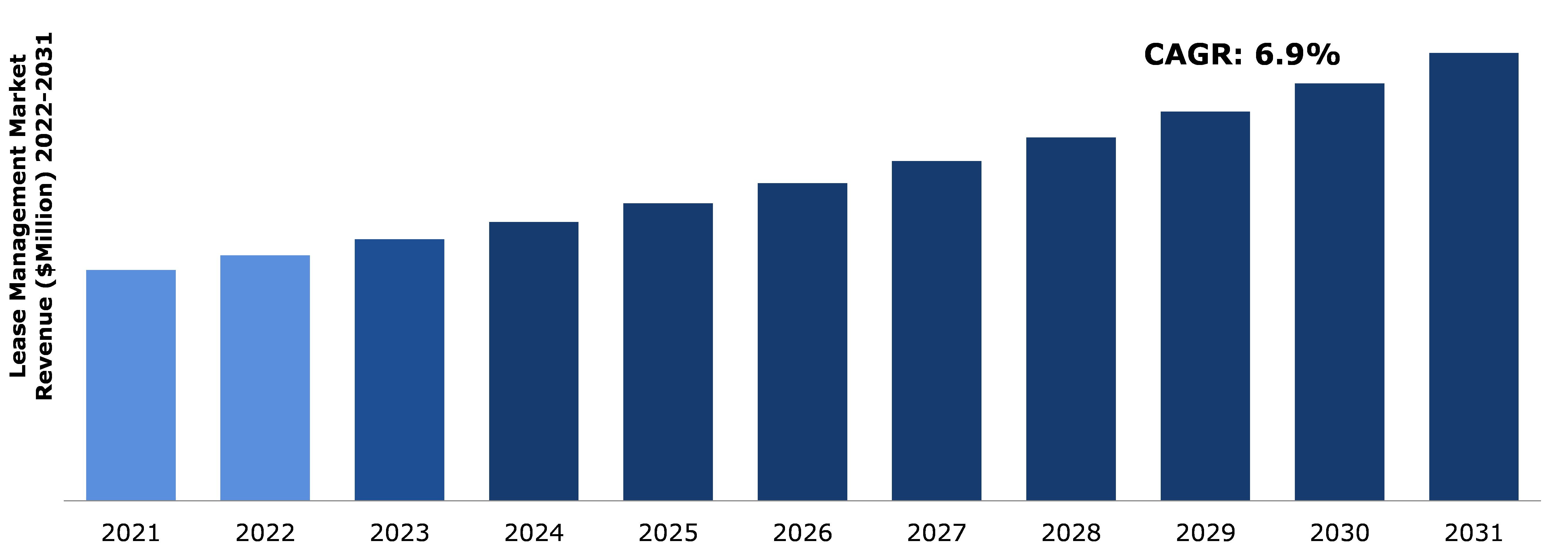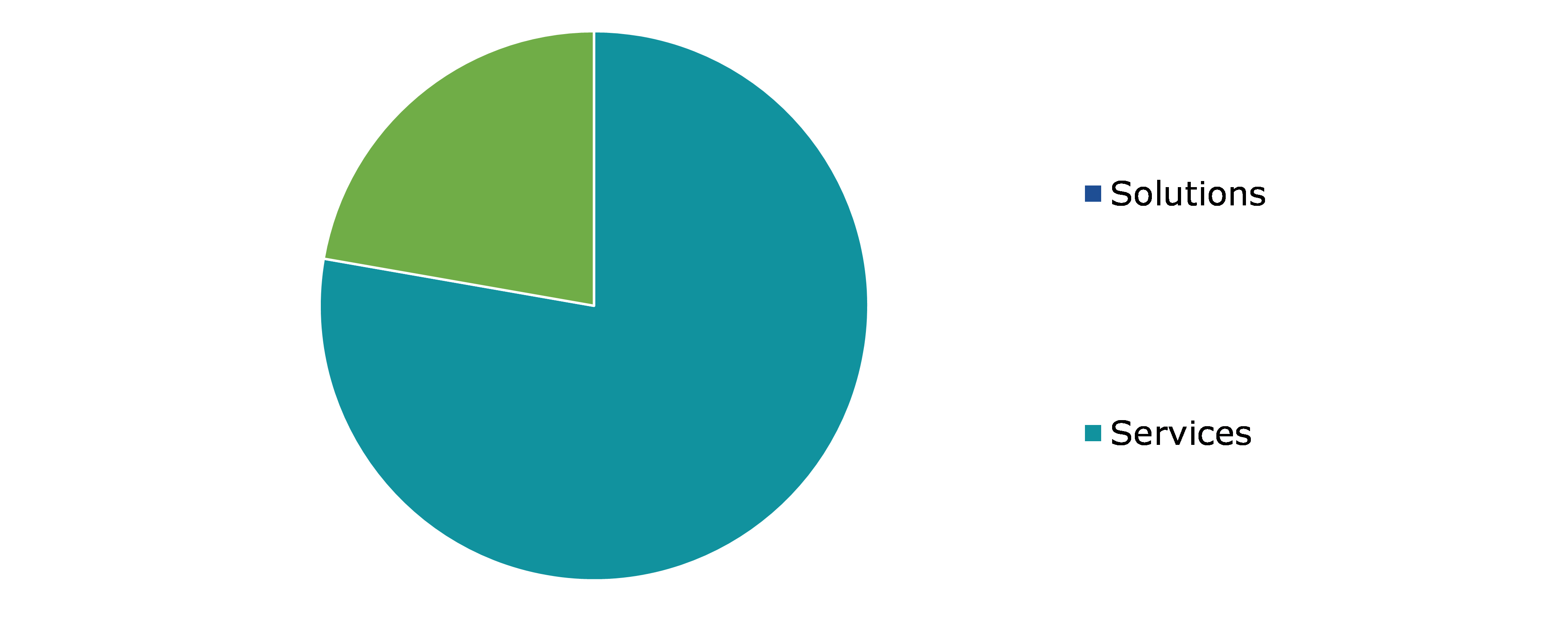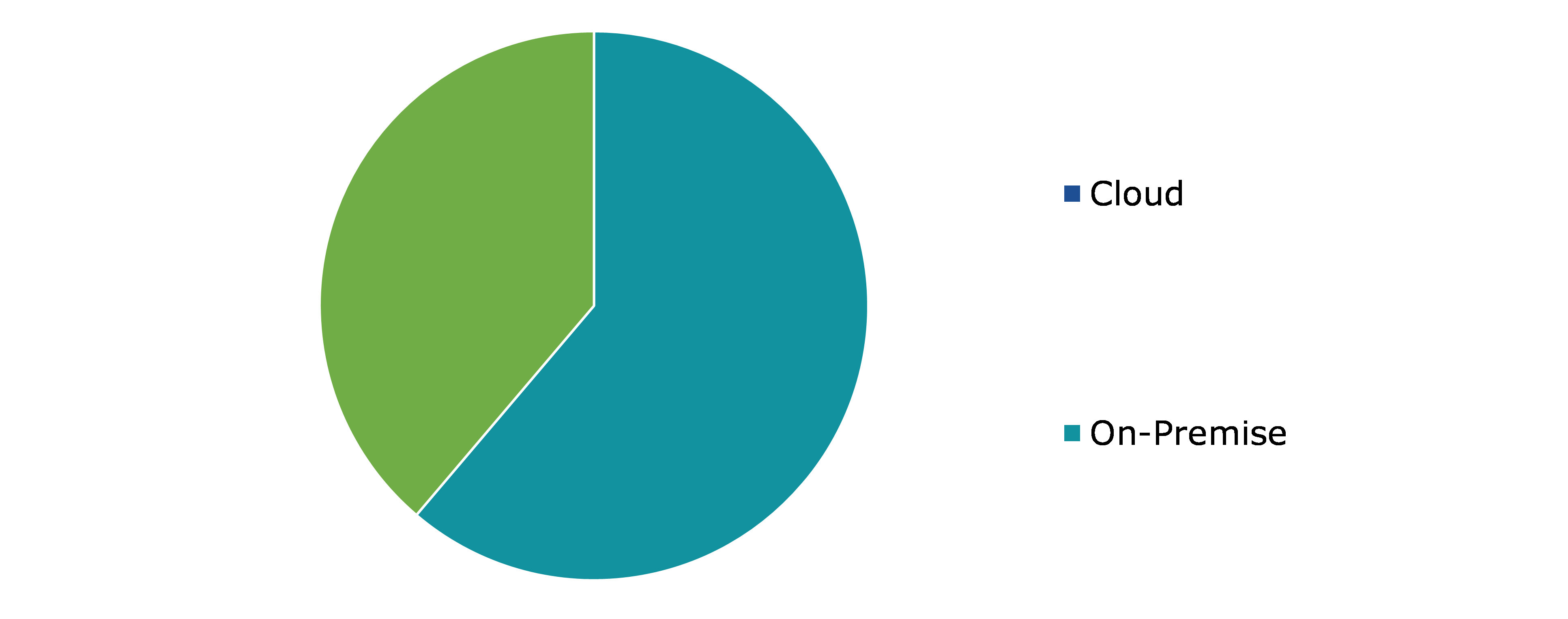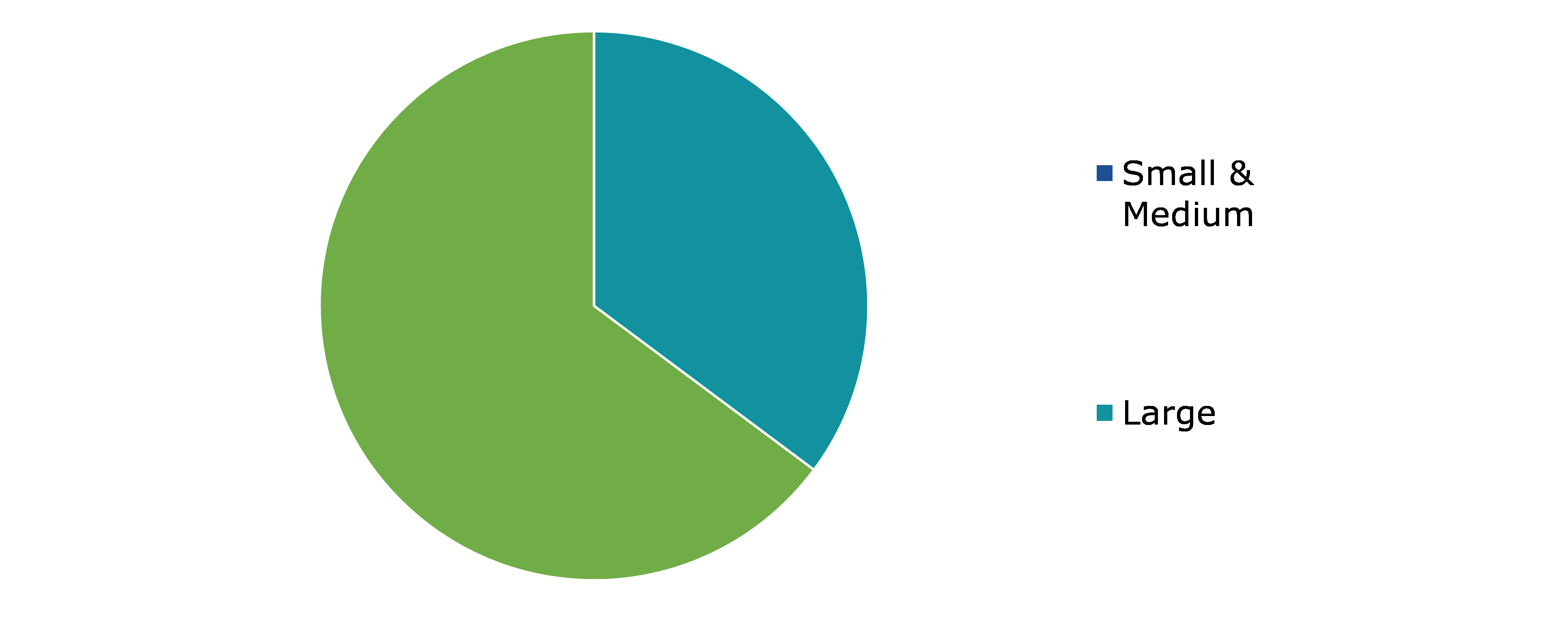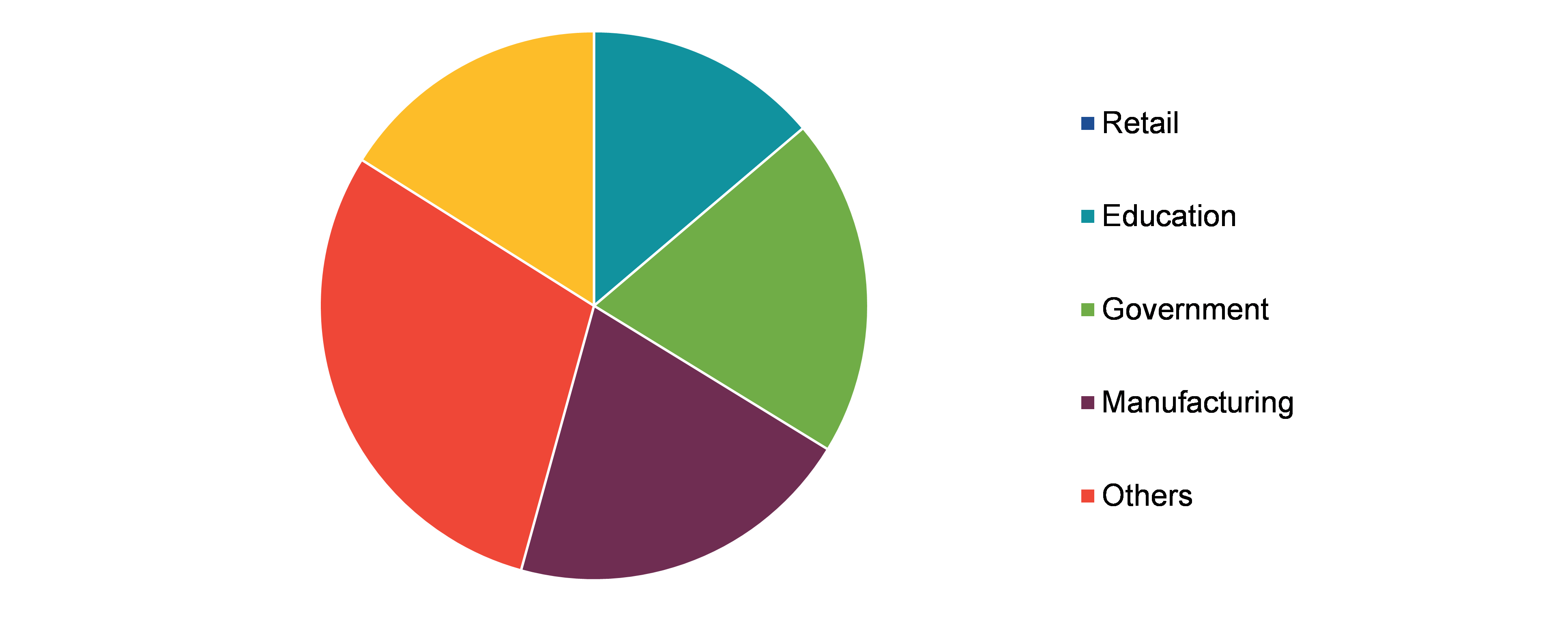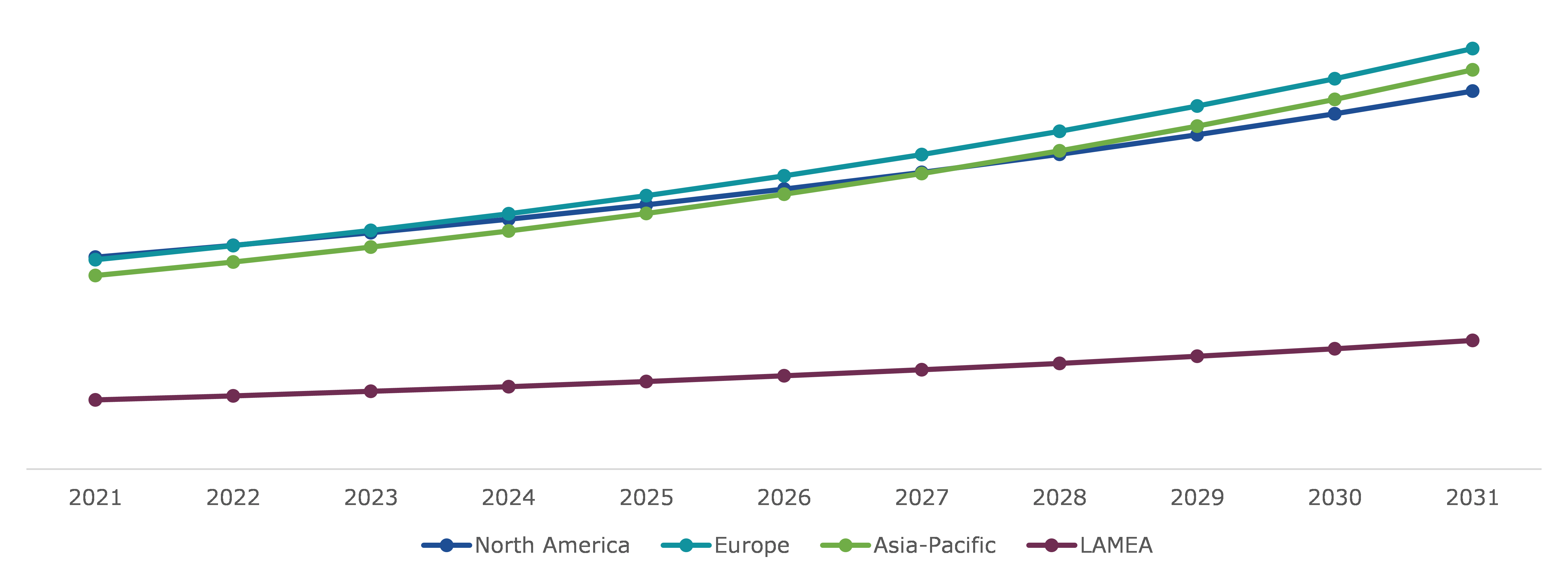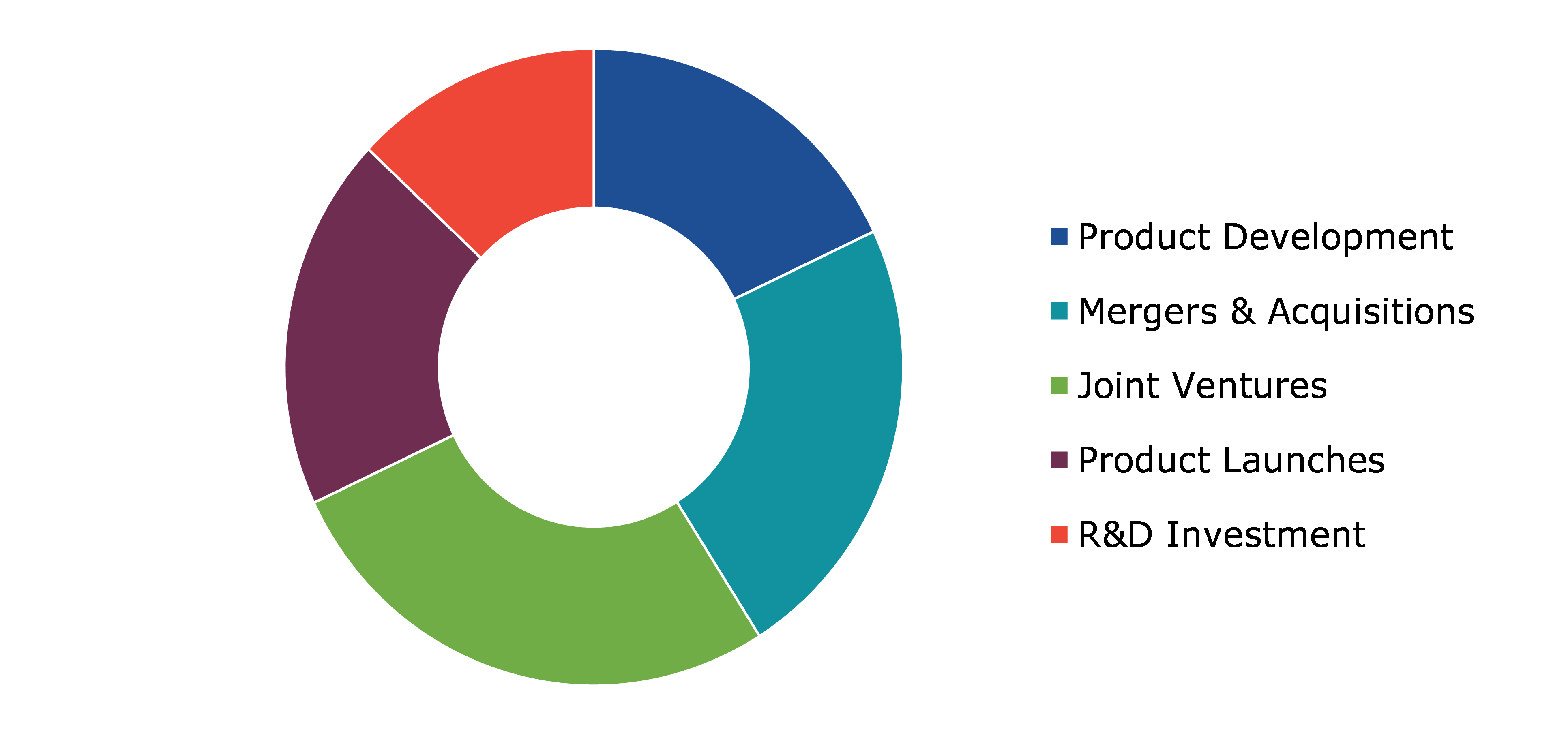Lease Management Market Report
RA00411
Lease Management Market by Component (Solution and Services), Deployment Mode (Cloud and On-premises), Enterprise Size (Small & Medium and Large), End-use Industry (Retail, Education, Government, Manufacturing, And Others), and Regional Analysis (North America, Europe, Asia-Pacific, and LAMEA): Global Opportunity Analysis and Industry Forecast, 2022–2031
Global Lease Management Market Analysis
The global lease management market size was $4,635.1 million in 2021 and is predicted to grow with a CAGR of 6.9%, by generating a revenue of $8,990.6 million by 2031.
Global Lease Management Market Synopsis
Among the data transparency initiatives, lease management is a comprehensive system that affects the entire workforce. Receiving rent from assets they own, paying rent for amenities they lease, as well as other tasks, are all included in lease management. It facilitates computerized business operations control and eliminates paper-based processes. Additionally, lease audits, lease reviews, and abstracting; common area maintenance (CAM) fees; accounting & processing; repairs & maintenance; lease renewal options, occupancy pricing analysis; information management & reporting; document storage & keeping; and operational cost reviews are all tasks that are covered by lease management. The COVID-19 outbreak is leading to the rise in demand for office mobility solutions, increase in demand for smart buildings to efficiently regulate leasing, and a tendency toward IT modernization for greater company performance.
However, the cost of successfully implementing this lease management software in a business is prohibitively expensive. Additionally, the largest barrier for the global lease management market in the forecast period is anticipated to be the cost of routine maintenance and updating of the software. Due to this, small and medium business owners and new businesses might not be able to afford lease management software. These factors are anticipated to restrain the lease management market growth during the forecast period.
The market is gaining pace around technologies such as Internet of Things (IoT), SaaS, cutting-edge new sensors, advanced analytics, mobility, and new development environments, enabling more demand for enterprise integration than ever before. This will eventually, have an impact on the implementation of lease management software across real estate organizations. To connect users via digital networking and improve project cooperation and space usage, lease management software vendors provide integrated solutions. In addition, to drive operations, decisions, and facility automation, the leasing management software can support device data from sensors, monitors, and smartphones. Contrary to traditional analytical tools, lease management software is both pre-configured for commercial use and already connected with the professional commercial lease management business process. Real-time analytics, predictive analytics, and the more recent presence analytics and cognitive analytics are all available with this system. These factors are anticipated to generate growth opportunities for the global lease management market.
According to regional analysis, the Europe lease management market accounted highest market share in 2021. Rise in adoption of lease management by several countries, such as France and Spain in this region, to manage and retain enormous volumes of data, is one important reason that is projected to drive growth of the global lease management market in Europe.
Lease Management Overview
A lease management system is created to meet all operational requirements of asset-based lending firms. A leasing management system is required to make data transparent among stakeholders, automate paperwork, and speed up user access to data. In addition, it provides integrated financial analysis tools and a central database that preserves information. This makes it possible for a customer to manage lease payments effectively, create abstractions and stack schedules, and accurately review lease-level financial data. Furthermore, to establish the possession of properties with a full perspective of their properties, lease management integrates its work with immovable portfolio management. The accomplishment of corporate objectives and management activities is made easier by leasing management.
COVID-19 Impact on Lease Management Market
Since the COVID-19 pandemic was initially identified, it has spread around the world and affected practically every industry's vertical. The pandemic has had a significant impact on the expansion of the world economy. The pandemic has an impact on the worldwide market in a number of ways, as it causes consumers to prefer cloud-based solutions over those that require on-premises deployment. Several businesses are thinking about switching to a virtual office because of the lockout and numerous government duties. To carry out their commercial activities in lease management, this may accelerate the penetration of technology such as lease management solutions. It makes it easier for real estate agents and related property managers to track all data and management-related information. Nowadays, most people choose to work remotely instead of sitting in an office. The business can function remotely without any interruptions thanks to the leasing management software's integration of all facility management data. At the time of the pandemic, it was anticipated that the rise in the tendency of working from home would be the main driving force for the global leasing management market.
Increase in the Need for Software as a Service (SaaS) Model in Lease Management is Expected to Drive the Lease Management Market Growth
The use of lease management allows for the daily, weekly, and monthly monitoring of business performance. The majority of software companies currently want to use cloud to run their products. With the aid of a web browser, apps such as Buildium, AppFolio Property Manager, and others enable users to access multiple online platforms. These programs are hosted on the cloud. The use of SaaS models by businesses for cost-effective remote access is anticipated to fuel growth in the global lease management market during the forecast period. Moreover, it is anticipated that one of the key drivers propelling the global market during the projected period will be the increase in demand for smart building projects.
Increased Cost of Investment for Installation of Lease Management Technology is anticipated to Restrain Lease Management Market Growth.
Implementing lease management software in an organization is quite costly. Additionally, the cost of routine software maintenance and updating is expected to be the major inhibitor of the global leasing management market throughout the projection period. As a result, lease management software is out of reach for small & medium enterprise and new businesses, which is expected to restrain the market throughout the forecast period. Moreover, the lease management software is unknown to many firms. Most businesses still use the old-fashioned way of keeping track of rental property information, which is expected to impede market expansion during the projected time.
Cutting-edge Technological Development in Lease Management Services May Create Lease Management Market Growth Opportunity.
One of the largest opportunities in the lease management market is emerging technology, such as the Internet of Things (IoT), which has the potential to transform the way real estate managers manage their properties. The adoption of IoT will greatly simplify operations because leasing information can be automatically collected by sensors, which can then be analyzed for maintenance activities at the highest efficiency. The adoption of IoT would greatly lower the load on leasing management tools and assist in obtaining correct results in the shortest amount of time. Even though the Internet of Things is still in its infancy, it has enormous development potential. This solution can provide predictive analytics, real-time analytics, presence analytics, and the more recent cognitive analytics. As a result, the development of the IoT market will undoubtedly have an impact on the global market for leasing management software.
Global Lease Management Market, by Component
Based on component, the market is further classified into solution and services. Among these, solution segments accounted for a dominating market share in 2021 and services is estimated to witness the fastest growth during the forecast period.
Global Lease Management Market, by Component, 2021
The solution segment accounted for a dominating market share in 2021. The solution segment plays a major role in revolutionizing the lease management market owing to their advantages in record keeping efficiently. Lease management system is an important solution for accuracy, easy accessibility, and management of documentation in retail or government sector which is expected to drive the growth of the solution segment of lease management market during the forecast period.
The services segment is estimated to witness the fastest growth during the forecast period. This is due to the increase in complexity of lease obligations, which drives the demand for advanced leasing management services for reporting. The service component provides end-to-end efficient solutions to establishments to efficiently control data and provide business insights, which is expected to drive the growth of the service segment of lease management market during the forecast period.
Global Lease Management Market, by Deployment
Based on deployment type, the global lease management market has been divided into on premises and cloud. Among these, cloud segment accounted for a dominating market share.
Global Lease Management Market, by Deployment, 2021
The cloud segment accounted for a dominating market share in 2021. Due to consumers' shifting preference away from the traditional on-premises lease management toward web-based leasing services, the cloud market is expected to have promising growth. In addition, the advantages of cloud installations, including their adaptability, economy of scale, automation, real-time access to leasing data, and other features, are boosting interest in cloud-based solutions.
Global lease Management Market, by Enterprise size
Based on enterprise size, the global lease management market has been divided into small & medium enterprises and large enterprises. Among these, the large enterprises segment accounted for a dominating market share.
Global Lease Management Market, by Enterprise Size, 2021
The large enterprises segment accounted for a dominating market share in 2021. Large firms benefit from lease management for a seamless flow of operational activities. The primary driving force for the segment is anticipated to be an increase in the use of lease management by large businesses and an increase in the demand from these businesses for professional management of their leasing portfolios during the forecasted period.
Global Lease Management Market, by End-use Industry
Based on end use industry, the global lease management market has been classified into retail, education, government, manufacturing, and others. Among these, manufacturing segment is expected to be the most dominant during the forecast period.
Global Lease Management Market, by End-use Industry, 2021
The manufacturing segment accounted for a dominating market share in 2021. The majority of lease management software is utilized in manufacturing units. Since the manufacturing sector relies heavily on contracts and leases with all the dealers and as every transaction must be closely watched, the segment market is expected to be driven by this trend during the forecast period.
Global Lease Management Market, Regional Insights
The lease management market was investigated across Europe, North America, Asia-Pacific, and LAMEA.
Global Lease Management Market Size &Forecast, by Region, 2022-2031 (USD Million)
The Lease Management Market in Europe to be the Most Dominant
The lease management market in Europe accounted for the dominant market share in 2021. The presence of several businesses around the region and an increase in investments made by most businesses to build up operational flow inside the region are anticipated to drive the regional market during the projected period. The firms are concentrating more on creating cutting-edge leasing management software for their individual businesses which is anticipated to dominate the regional market during the projected period.
Global Lease Management Market Competitive Scenario
Product development, partnership, acquisition, product launch, collaborations, and technological development are the common strategies followed by major lease management market players. For instance, in November 2020, Nakisa, Inc., a technology firm specializing in enterprise business solutions, has acquired IMNAT Software, Inc., a cloud-based real estate management solutions provider, to increase its focus on centralizing and automating compliance and accounting operations.
Some of the leading players in lease management market are Lease Accelerator, Inc., CoStar Group, FORTUNE Media IP Limited, Trimble Inc., Nakisa, RealPage, Inc., Oracle Corporation., IBM, Innolux Corporation, and SAP.
| Aspect | Particulars |
| Historical Market Estimations | 2020 |
| Base Year for Market Estimation | 2021 |
| Forecast timeline for Market Projection | 2022-2031 |
| Geographical Scope | Europe, North America, Asia-Pacific, and LAMEA |
| Segmentation by Component
|
|
| Segmentation by Deployment |
|
| Segmentation by Enterprise Size |
|
| Segmentation by End Use Industry |
|
| Key Companies Profiled |
|
Q1. What is the size of the lease management market?
A. The global lease management market size was over $4,635.1 million in ¬¬2021 and is further anticipated to reach $8,990.6 million by 2031.
Q2. Which are the leading companies in the lease management market?
A. IBM and SAP are some of the key players in the global lease management market.
Q3. Which region possesses greater investment opportunities in the coming future?
A. Asia-Pacific possesses great investment opportunities for the investors to witness the most promising market growth in the coming years.
Q4. What is the growth rate of the Asia-Pacific market?
A. The Asia-Pacific lease management market is anticipated to grow at 7.56% CAGR during the forecast period.
Q5. What are the strategies opted by the leading players in this market?
A. Product development and joint ventures are the key strategy opted by the operating companies in this market.
Q6. Which companies are investing more on R&D practices?
A. SAP and IBM are the company that invests more in R&D activities for developing new products and technologies.
1.Research Methodology
1.1.Desk Research
1.2.Real time insights and validation
1.3.Forecast model
1.4.Assumptions and forecast parameters
1.5.Market size estimation
1.5.1.Top-down approach
1.5.2.Bottom-up approach
2.Report Scope
2.1.Market definition
2.2.Key objectives of the study
2.3.Report overview
2.4.Market segmentation
2.5.Overview of the impact of COVID-19 on Global Lease Management market
3.Executive Summary
4.Market Overview
4.1.Introduction
4.2.Growth impact forces
4.2.1.Drivers
4.2.2.Restraints
4.2.3.Opportunities
4.3.Market value chain analysis
4.3.1.List of raw material suppliers
4.3.2.List of manufacturers
4.3.3.List of distributors
4.4.Innovation & sustainability matrices
4.4.1.Technology matrix
4.4.2.Regulatory matrix
4.5.Porter’s five forces analysis
4.5.1.Bargaining power of suppliers
4.5.2.Bargaining power of consumers
4.5.3.Threat of substitutes
4.5.4.Threat of new entrants
4.5.5.Competitive rivalry intensity
4.6.PESTLE analysis
4.6.1.Political
4.6.2.Economical
4.6.3.Social
4.6.4.Technological
4.6.5.Environmental
4.7.Impact of COVID-19 on Lease management market
4.7.1.Pre-covid market scenario
4.7.2.Post-covid market scenario
5.Lease management Market Analysis, by Component
5.1.Overview
5.2.Solution
5.2.1.Definition, key trends, growth factors, and opportunities
5.2.2.Market size analysis, by region
5.2.3.Market share analysis, by country
5.3.Services
5.3.1.Definition, key trends, growth factors, and opportunities
5.3.2.Market size analysis, by region
5.3.3.Market share analysis, by country
5.4.Research Dive Exclusive Insights
5.4.1.Market attractiveness
5.4.2.Competition heatmap
6.Lease management Market Analysis, by Deployment Mode
6.1.Cloud
6.1.1.Definition, key trends, growth factors, and opportunities
6.1.2.Market size analysis, by region
6.1.3.Market share analysis, by country
6.2.On-premise
6.2.1.Definition, key trends, growth factors, and opportunities
6.2.2.Market size analysis, by region
6.2.3.Market share analysis, by country
6.3.Research Dive Exclusive Insights
6.3.1.Market attractiveness
6.3.2.Competition heatmap
7.Lease management Market Analysis, by Enterprise Size
7.1.Overview
7.2.Small & Medium
7.2.1.Definition, key trends, growth factors, and opportunities
7.2.2.Market size analysis, by region
7.2.3.Market share analysis, by country
7.3.Large
7.3.1.Definition, key trends, growth factors, and opportunities
7.3.2.Market size analysis, by region
7.3.3.Market share analysis, by country
7.4.Research Dive Exclusive Insights
7.4.1.Market attractiveness
7.4.2.Competition heatmap
8.Lease management Market Analysis, by End-use
8.1.Overview
8.2.Retail
8.2.1.Definition, key trends, growth factors, and opportunities
8.2.2.Market size analysis, by region
8.2.3.Market share analysis, by country
8.3.Education
8.3.1.Definition, key trends, growth factors, and opportunities
8.3.2.Market size analysis, by region
8.3.3.Market share analysis, by country
8.4.Government
8.4.1.Definition, key trends, growth factors, and opportunities
8.4.2.Market size analysis, by region
8.4.3.Market share analysis, by country
8.5.Manufacturing
8.5.1.Definition, key trends, growth factors, and opportunities
8.5.2.Market size analysis, by region
8.5.3.Market share analysis, by country
8.6.Others
8.6.1.Definition, key trends, growth factors, and opportunities
8.6.2.Market size analysis, by region
8.6.3.Market share analysis, by country
8.7.Research Dive Exclusive Insights
8.7.1.Market attractiveness
8.7.2.Competition heatmap
9.Lease management Market, by Region
9.1.North America
9.1.1.U.S.
9.1.1.1.Market size analysis, by Component
9.1.1.2.Market size analysis, by Deployment Mode
9.1.1.3.Market size analysis, by Enterprise Size
9.1.1.4.Market size analysis, by End-use
9.1.2.Canada
9.1.2.1.Market size analysis, by Component
9.1.2.2.Market size analysis, by Deployment Mode
9.1.2.3.Market size analysis, by Enterprise Size
9.1.2.4.Market size analysis, by End-use
9.1.3.Mexico
9.1.3.1.Market size analysis, by Component
9.1.3.2.Market size analysis, by Deployment Mode
9.1.3.3.Market size analysis, by Enterprise Size
9.1.3.4.Market size analysis, by End-use
9.1.4.Research Dive Exclusive Insights
9.1.4.1.Market attractiveness
9.1.4.2.Competition heatmap
9.2.Europe
9.2.1.Germany
9.2.1.1.Market size analysis, by Component
9.2.1.2.Market size analysis, by Deployment Mode
9.2.1.3.Market size analysis, by Enterprise Size
9.2.1.4.Market size analysis, by End-use
9.2.2.UK
9.2.2.1.Market size analysis, by Component
9.2.2.2.Market size analysis, by Deployment Mode
9.2.2.3.Market size analysis, by Enterprise Size
9.2.2.4.Market size analysis, by End-use
9.2.3.France
9.2.3.1.Market size analysis, by Component
9.2.3.2.Market size analysis, by Deployment Mode
9.2.3.3.Market size analysis, by Enterprise Size
9.2.3.4.Market size analysis, by End-use
9.2.4.Spain
9.2.4.1.Market size analysis, by Component
9.2.4.2.Market size analysis, by Deployment Mode
9.2.4.3.Market size analysis, by Enterprise Size
9.2.4.4.Market size analysis, by End-use
9.2.5.Italy
9.2.5.1.Market size analysis, by Component
9.2.5.2.Market size analysis, by Deployment Mode
9.2.5.3.Market size analysis, by Enterprise Size
9.2.5.4.Market size analysis, by End-use
9.2.6.Rest of Europe
9.2.6.1.Market size analysis, by Component
9.2.6.2.Market size analysis, by Deployment Mode
9.2.6.3.Market size analysis, by Enterprise Size
9.2.6.4.Market size analysis, by End-use
9.2.7.Research Dive Exclusive Insights
9.2.7.1.Market attractiveness
9.2.7.2.Competition heatmap
9.3.Asia Pacific
9.3.1.China
9.3.1.1.Market size analysis, by Component
9.3.1.2.Market size analysis, by Deployment Mode
9.3.1.3.Market size analysis, by Enterprise Size
9.3.1.4.Market size analysis, by End-use
9.3.2.Japan
9.3.2.1.Market size analysis, by Component
9.3.2.2.Market size analysis, by Deployment Mode
9.3.2.3.Market size analysis, by Enterprise Size
9.3.2.4.Market size analysis, by End-use
9.3.3.India
9.3.3.1.Market size analysis, by Component
9.3.3.2.Market size analysis, by Deployment Mode
9.3.3.3.Market size analysis, by Enterprise Size
9.3.3.4.Market size analysis, by End-use
9.3.4.Australia
9.3.4.1.Market size analysis, by Component
9.3.4.2.Market size analysis, by Deployment Mode
9.3.4.3.Market size analysis, by Enterprise Size
9.3.4.4.Market size analysis, by End-use
9.3.5.South Korea
9.3.5.1.Market size analysis, by Component
9.3.5.2.Market size analysis, by Deployment Mode
9.3.5.3.Market size analysis, by Enterprise Size
9.3.5.4.Market size analysis, by End-use
9.3.6.Rest of Asia Pacific
9.3.6.1.Market size analysis, by Component
9.3.6.2.Market size analysis, by Deployment Mode
9.3.6.3.Market size analysis, by Enterprise Size
9.3.6.4.Market size analysis, by End-use
9.3.7.Research Dive Exclusive Insights
9.3.7.1.Market attractiveness
9.3.7.2.Competition heatmap
9.4.LAMEA
9.4.1.Brazil
9.4.1.1.Market size analysis, by Component
9.4.1.2.Market size analysis, by Deployment Mode
9.4.1.3.Market size analysis, by Enterprise Size
9.4.1.4.Market size analysis, by End-use
9.4.2.Saudi Arabia
9.4.2.1.Market size analysis, by Component
9.4.2.2.Market size analysis, by Deployment Mode
9.4.2.3.Market size analysis, by Enterprise Size
9.4.2.4.Market size analysis, by End-use
9.4.3.UAE
9.4.3.1.Market size analysis, by Component
9.4.3.2.Market size analysis, by Deployment Mode
9.4.3.3.Market size analysis, by Enterprise Size
9.4.3.4.Market size analysis, by End-use
9.4.4.South Africa
9.4.4.1.Market size analysis, by Component
9.4.4.2.Market size analysis, by Deployment Mode
9.4.4.3.Market size analysis, by Enterprise Size
9.4.4.4.Market size analysis, by End-use
9.4.5.Rest of LAMEA
9.4.5.1.Market size analysis, by Component
9.4.5.2.Market size analysis, by Deployment Mode
9.4.5.3.Market size analysis, by Enterprise Size
9.4.5.4.Market size analysis, by End-use
9.4.6.Research Dive Exclusive Insights
9.4.6.1.Market attractiveness
9.4.6.2.Competition heatmap
10.Competitive Landscape
10.1.Top winning strategies, 2021
10.1.1.By strategy
10.1.2.By year
10.2.Strategic overview
10.3.Market share analysis, 2021
11.Company Profiles
11.1.Lease Accelerator, Inc.
11.1.1.Overview
11.1.2.Business segments
11.1.3.Product portfolio
11.1.4.Financial performance
11.1.5.Recent developments
11.1.6.SWOT analysis
11.1.7.Research Dive Analyst View
11.2.CoStar Group,
11.2.1.Overview
11.2.2.Business segments
11.2.3.Product portfolio
11.2.4.Financial performance
11.2.5.Recent developments
11.2.6.SWOT analysis
11.2.7.Research Dive Analyst View
11.3.FORTUNE Media IP Limited
11.3.1.Overview
11.3.2.Business segments
11.3.3.Product portfolio
11.3.4.Financial performance
11.3.5.Recent developments
11.3.6.SWOT analysis
11.3.7.Research Dive Analyst View
11.4.IBM
11.4.1.Overview
11.4.2.Business segments
11.4.3.Product portfolio
11.4.4.Financial performance
11.4.5.Recent developments
11.4.6.SWOT analysis
11.4.7.Research Dive Analyst View
11.5.Oracle Corporation
11.5.1.Overview
11.5.2.Business segments
11.5.3.Product portfolio
11.5.4.Financial performance
11.5.5.Recent developments
11.5.6.SWOT analysis
11.5.7.Research Dive Analyst View
11.6.Trimble Inc.
11.6.1.Overview
11.6.2.Business segments
11.6.3.Product portfolio
11.6.4.Financial performance
11.6.5.Recent developments
11.6.6.SWOT analysis
11.6.7.Research Dive Analyst View
11.7.Nakisa
11.7.1.Overview
11.7.2.Business segments
11.7.3.Product portfolio
11.7.4.Financial performance
11.7.5.Recent developments
11.7.6.SWOT analysis
11.7.7.Research Dive Analyst View
11.8.RealPage, Inc.
11.8.1.Overview
11.8.2.Business segments
11.8.3.Product portfolio
11.8.4.Financial performance
11.8.5.Recent developments
11.8.6.SWOT analysis
11.8.7.Research Dive Analyst View
11.9.Innolux Corporation
11.9.1.Overview
11.9.2.Business segments
11.9.3.Product portfolio
11.9.4.Financial performance
11.9.5.Recent developments
11.9.6.SWOT analysis
11.9.7.Research Dive Analyst View
11.10.SAP
11.10.1.Overview
11.10.2.Business segments
11.10.3.Product portfolio
11.10.4.Financial performance
11.10.5.Recent developments
11.10.6.SWOT analysis
11.10.7.Research Dive Analyst View
12.Appendix
12.1.Parent & peer market analysis
12.2.Premium insights from industry experts
12.3.Related reports
Lease management is also referred to as lease administration, which includes the day-to-day execution of tasks related to a company’s lease portfolio. Lease management includes several tasks including document management, reporting, coordinating between stakeholders, and a myriad of administrative tasks. Lease administrators are responsible for tracking, reporting on, and optimizing property and equipment obligations. This helps asset-based lending firms to achieve compliance, mitigate risks, and lower costs. The lease management process starts with negotiations and moves forward to renewals. The common tasks of lease management include lease negotiation, lease accounting, and ongoing lease tracking.
Forecast Analysis of the Global Lease Management Market
With the increasing need for a Software-as-a-Service (SaaS) model in lease management, the global lease management market is expected to experience significant growth during the analysis timeframe. Besides, the increasing demand for smart building projects is further expected to bolster the growth of the market during the forecast period. Moreover, cutting-edge technological development such as the Internet of Things (IoT) in lease management services is predicted to create massive growth opportunities for the market over the estimated timeframe. However, the increased cost of investment for the installation of lease management technology may hinder the growth of the market throughout the forecast period.
According to the report published by research Dive, the global lease management market is anticipated to generate a revenue of $8,990.6 million and rise at a CAGR of 6.9% during the analysis timeframe from 2022 to 2031. The major players of the market include Nakisa, Trimble Inc., RealPage, Inc., FORTUNE Media IP Limited, Oracle Corporation, CoStar Group, SAP, IBM, Lease Accelerator, Inc., Innolux Corporation, and many more.
Lease Management Market Trends & Developments
The key companies operating in the industry are adopting various growth strategies & business tactics such as partnerships, collaborations, mergers & acquisitions, and launches to maintain a robust position in the overall market, which is subsequently helping the global lease management market to grow exponentially. For instance:
- In July 2020, Lease Accelerator Inc., a leading provider of enterprise lease life-cycle automation software, launched EZLease software, which is an automated lease calculator for rapid and low-cost compliance. This particular software is designed to support the requirements of lessees and lessors for all standards in one fully-integrated application. With the help of EZLease, the lease data could be managed by the lessees and lessors at the asset or portfolio level with full data validation and over 15 standard reports.
- In April 2021, MRI Software, a leading provider of innovative real estate software applications and hosted solutions announced its acquisition of Trimble, a California-based industrial technology company transforming the way the world works by delivering solutions. With this acquisition, MRI Software expanded its workplace management software with space scheduling, booking, and facilities management capabilities and complemented its accounting and administrative software for real estate owners and operators.
- In February 2022, RealPage, Inc., an American multinational corporation that provides property management software for the multifamily, commercial, single-family, and vacation rental housing industries announced its partnership with Measurabl, Inc., the world’s most widely adopted ESG solution for real estate. With this partnership, the companies aimed to help owners of commercial, senior, university, multifamily, and another real estate to meet their sustainability goals and mandates with technology integration, professional services, and big data analytics.
Most Profitable Region
The Europe region of the lease management market is expected to dominate the market and is projected to hold the largest share of the market. The existence of several businesses around the region and the increasing investments made by most businesses to build operational flow inside the region is expected to drive the regional growth of the market. In addition, the firms of this region are focusing on the development of cutting-edge leasing management software to improve their functionalities is expected to fortify the growth of the market.
Covid-19 Impact on the Lease Management Market
Though the outbreak of the Covid-19 pandemic has devastated several other industries, it has had a positive impact on the lease management market. This is mainly because of the increasing preference of consumers towards cloud-based solutions. Furthermore, due to the prolonged lockdown and stringent government regulations, many businesses have adopted virtual offices which has further increased the penetration of technology such as lease management solutions during the pandemic period.
Personalize this research
- Triangulate with your own data
- Request your format and definition
- Get a deeper dive on a specific application, geography, customer or competitor
- + 1-888-961-4454 Toll - Free
- support@researchdive.com

